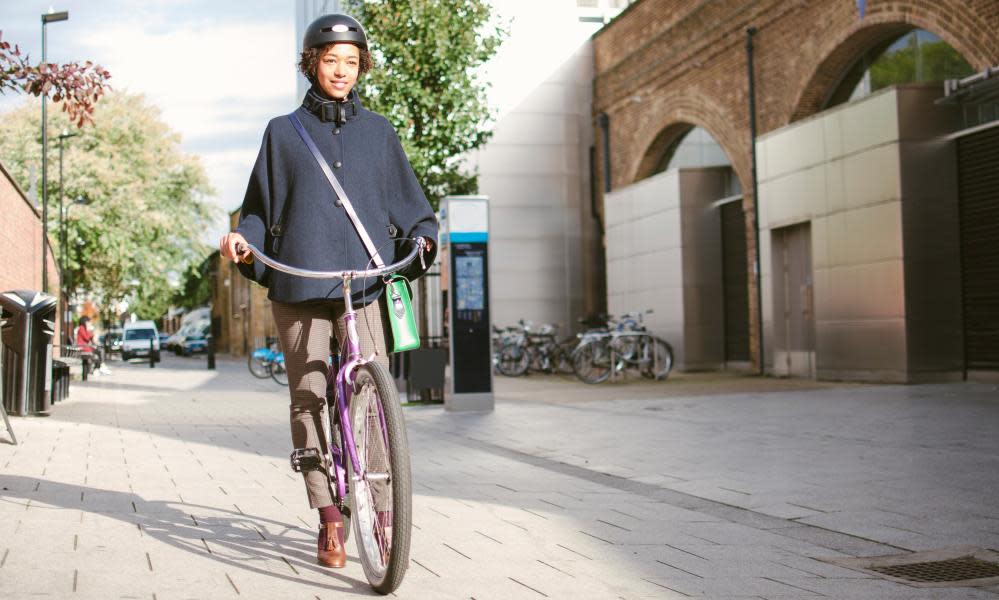Cycling: here’s how to make buying a new bike an easy ride

Although prices of new bicycles have shot up in recent years, thanks in part to a Covid-induced bike-buying frenzy, it is still possible to find a decent one at a cost that won’t break the bank – if you know where to look.
In fact, now is a very good time to buy a new bike because sluggish sales have prompted many big retailers to knock 20-30% off. For first-time buyers, the bike market can seem daunting but here’s the Guardian Money guide to buying a bike.
Buying new
The first rule of buying a new bike is not to look at anything less than £300 (unless it is a heavily discounted decent bike) as, chances are, it will be a drudge to ride and feature poor components. However, if you can spend £400-£600, according to BikeRadar’s deputy editor, Jack Luke, you will get a decently specced bike that will be fun to ride (not too heavy) – one that will allow you to commute in the week and enjoy leisure rides at weekends.
For most people getting back on two wheels, it makes a lot of sense to buy a hybrid bike – a flattish handlebarred model with a fairly upright (comfortable) riding position.
Cycling Weekly described the £400-ish Pinnacle Lithium 3 as the “best commuter bike for a jack of all trades”, and it is hard to disagree. You get a lightweight frame and hydraulic disc brakes. These bikes are exclusive to Evans Cycles, part of Frasers Group, the Sports Direct owner. For this reason, we would recommend you only buy this bike in person so you can try it for size, rather than ordering online. If you have an Evans near you, these are great bikes.
Another great starter bike to look at is the Specialized Sirrus 1.0, which can be found new for £375. However, be aware that, like the Pinnacle, this doesn’t come with mudguards and a pannier rack, which are a must if you are hoping to ride comfortably when it rains or has rained, or you want to carry work clothes and so on.
Two recommended hybrid commuter bikes that have both these fitted as standard are the dependable £480 Ridgeback Speed, and Decathlon’s £500 Elops 500. The latter is available with men’s and women’s frames, with built-in lights. We would suggest the Ridgeback just shades it but both bikes offer dependable urban transport.
If you are on a tighter budget and still want to buy new, the £320 Carrera Subway 1 from Halfords is a good option. It also comes in men’s and women’s versions, and has the ability to mount mudguards and panniers, even with its larger tyres. Luke says these have proved themselves over the years and have a loyal following among those wanting cheap transport.
For those able to spend a bit more, BikeRadar’s hybrid guide has some more expensive options in the £600-£1,000-plus bracket that will give a noticeable step up in quality.
For those looking for a newbie road bike (with drop handlebars), Decathlon’s £350 Triban RC120 is the standout value purchase.
The best-value new gravel bike is currently the £650 Voodoo Nakisi, according to Luke.
Meanwhile, there are a host of electric bikes around the £2,000 mark. Guardian Money particularly likes the ultra-cool VanMoof S4, which the makers say is “practically unstealable”.
Luke advises new bike buyers to favour their independent bike shop (if they have one), where they will get some proper advice, and help if they have a problem. It is worth visiting a couple of bike shops, as some will only stock one brand – for example, Trek – and another model may be a better fit.
The final piece of “buying new” advice is to buy the bike through your employer’s cycle-to-work scheme, if that is an option. Most big employers now offer this, and there is no compulsion to actually cycle to work. Basic-rate taxpayers will save 32% off the purchase price, while higher-rate taxpayers (those earning more than £50,271) receive a 42% discount through the salary sacrifice scheme. You can add a helmet, rack, coat, etc, and you can also buy an electric model. There is a useful guide to such schemes here.
What about used?
If you have a smaller budget, you will generally find a better bike in the secondhand market than opting for a cheaper new one. Sites such as eBay, Gumtree and Facebook Marketplace are all awash with used bikes in various states of repair. Again, you should be looking for a quality bike – ideally one that cost the first owner a fair sum but has been sitting unused in the garage. Plenty of people who bought bikes during Covid are selling them now after losing interest, and there are some real bargains out there.
Luke advises buyers to take someone who knows a bit about bikes along with you, as “it’s pretty easy to disguise the true state of a bike that’s been heavily used”.
The fear is that you buy a used bike and gears start slipping, at which point you need to change the chain, cassette and possibly the chainset – wiping out the savings you made.
Perhaps a better bet than trawling the private ads is to buy from one of the growing number of bike cooperatives and recycling projects that have sprung up across the country. For example, the Bristol Bike Project has a big turnover of upcycled bikes for sale and is a great scheme to invest your money in. There are similar projects across the UK, mostly in cities. They are also great places for affordable repairs.
Finally, don’t forget a decent lock. The gold-rated OnGuard Pitbull U-lock with cable is an absolute bargain at £25. Unless you ride a super-expensive machine, look no further.


